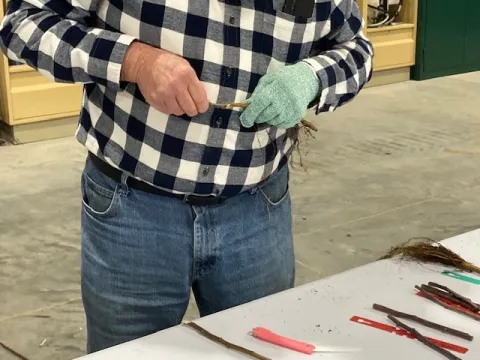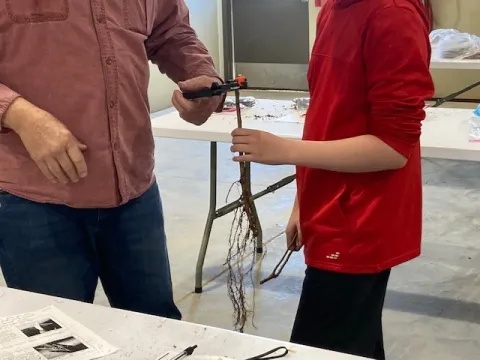Apple Grafting Class held March 28th

Photo taken by Shawn Hendrickson, Tennessee Department of Agriculture Division of Forestry, Asst. District Forester-State Forests
Tennessee Department of Agriculture Division of Forestry and the UT Extension Union County office hosted an apple grafting class in Chuck Swan State Forest. This collaborative event gave participants a hands-on opportunity to learn how to graft apple tree varieties onto different rootstocks. Class attendees took home at least 3 new apple tree varieties.
Grafting apple trees is a technique practiced for a variety of reasons, all aimed at maximizing the benefits that come from combining the desirable characteristics of different apple varieties into a single tree. This process involves joining the tissues of two different plants so they grow as one. The reasons for grafting apple trees include many benefits.
The rootstock (the bottom part of the graft that forms the root system) may be chosen for its resistance to certain soil-borne diseases, pests, or environmental conditions like drought or cold, which the scion (the top part that grows from the graft and produces the fruit) may lack.
Grafting allows for control over the size of the apple tree. Dwarf and semi-dwarf rootstocks result in smaller trees that are easier to manage, harvest, and require less space, making them ideal for home gardens or orchards where space is limited.
Trees grown from seeds can take many years to produce fruit, whereas grafted trees can bear fruit much sooner. This is because the scion is usually taken from a mature, fruiting tree, and it retains its maturity even after it's grafted onto a rootstock.
Grafting ensures that the fruit produced is consistent in quality and type. Since apple seeds can produce trees that are genetically different from the parent, grafting is a way to replicate the desired characteristics of the apple variety.
Grafting can be used to repair damaged trees or change an existing orchard to a more desirable variety without having to replant the entire orchard. This is done by grafting new scions onto the existing rootstocks.
Grafting helps in preserving rare, heirloom, or historical apple varieties that might otherwise be lost. By grafting these varieties onto hardy rootstocks, they can be grown and enjoyed even in conditions that might not be ideal for the original variety.
Overall, grafting is a valuable horticultural technique that combines the best qualities of different apple varieties to create trees that are more productive, easier to manage, and capable of growing in a variety of conditions. We hold learning events like this routinely, contact us at UT Extension Union County to sign up for future opportunities shannon@tennessee.edu
- Log in to post comments
